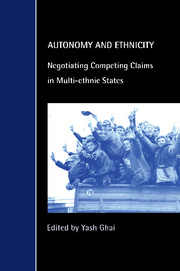Book contents
- Frontmatter
- Contents
- Acknowledgements
- List of Contributors
- 1 Ethnicity and Autonomy: A Framework for Analysis
- Part I Operating Autonomies
- 2 Federalism and Diversity in Canada
- 3 Federalism and Diversity in India
- 4 Autonomy Regimes in China: Coping with Ethnic and Economic Diversity
- 5 How the Centre Holds: Managing Claims for Regional and Ethnic Autonomy in a Democratic South Africa
- 6 Autonomous Communities and the Ethnic Settlement in Spain
- Part II Failed Autonomies
- Part III Seeking Autonomies
- List of Cases
- List of Legislation
- Index
2 - Federalism and Diversity in Canada
Published online by Cambridge University Press: 06 July 2010
- Frontmatter
- Contents
- Acknowledgements
- List of Contributors
- 1 Ethnicity and Autonomy: A Framework for Analysis
- Part I Operating Autonomies
- 2 Federalism and Diversity in Canada
- 3 Federalism and Diversity in India
- 4 Autonomy Regimes in China: Coping with Ethnic and Economic Diversity
- 5 How the Centre Holds: Managing Claims for Regional and Ethnic Autonomy in a Democratic South Africa
- 6 Autonomous Communities and the Ethnic Settlement in Spain
- Part II Failed Autonomies
- Part III Seeking Autonomies
- List of Cases
- List of Legislation
- Index
Summary
THE RELEVANCE OF THE CANADIAN EXAMPLE
In a book aimed at exploring the role of federal political systems and autonomy arrangements in the management of ethnic differences and conflicts, this chapter focuses on the lessons, positive and negative, provided by the Canadian experience. While, in many respects, there are significant contrasts between Canada and other federations that must always be borne in mind, there are some features of the Canadian federation which make it particularly relevant to the examination of the interface between federalism and ethnic diversity. Unlike some other federations, such as the United States and Switzerland which were created by the aggregation of pre-existing states and cantons, the formation of Canada involved a substantial devolutionary process. A major part of its creation as a federation in 1867 was the splitting of the formerly unitary Province of Canada into two new provinces (Ontario, predominantly English-speaking and Protestant, and Quebec, predominantly Frenchspeaking and Roman Catholic), each autonomous and responsible for its own affairs in those areas where the two communities were sharply divided. To these provinces were added two smaller provinces (New Brunswick and Nova Scotia).
The Canadian founders, concerned about maintaining effective unity, in 1867 adopted a predominantly federal structure that combined provincial autonomy with some constitutional quasi-unitary central controls over the provinces. Thus, the Canadian federal constitution, like those later established in India and Malaysia, and most recently in South Africa, was a hybrid combining a basically federal form with some unitary features.
- Type
- Chapter
- Information
- Autonomy and EthnicityNegotiating Competing Claims in Multi-Ethnic States, pp. 29 - 52Publisher: Cambridge University PressPrint publication year: 2000
- 2
- Cited by



